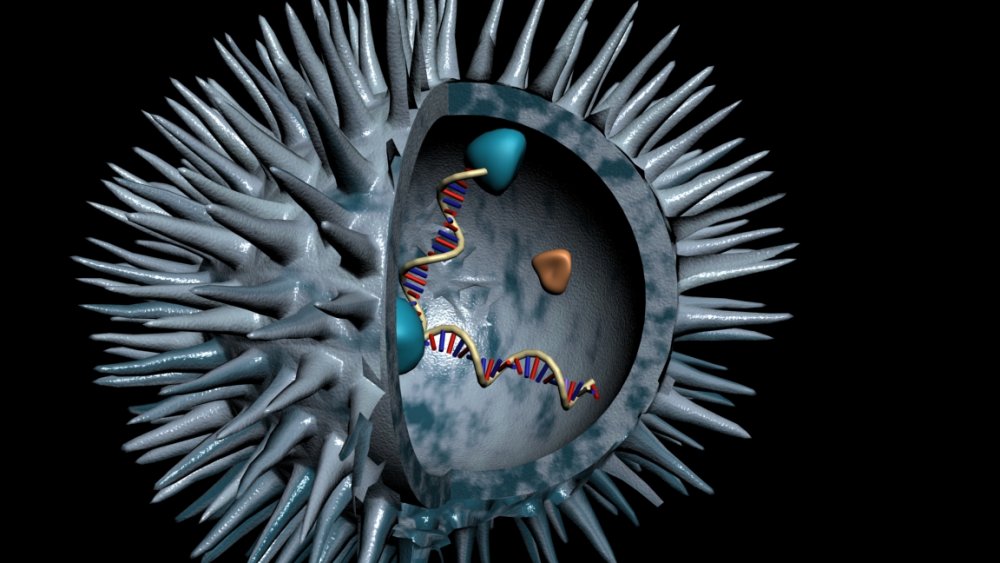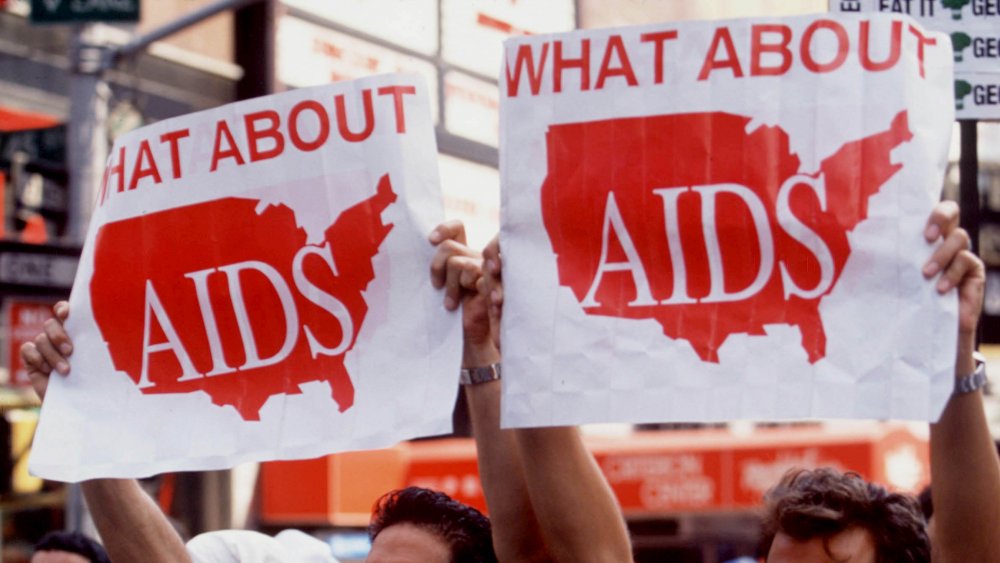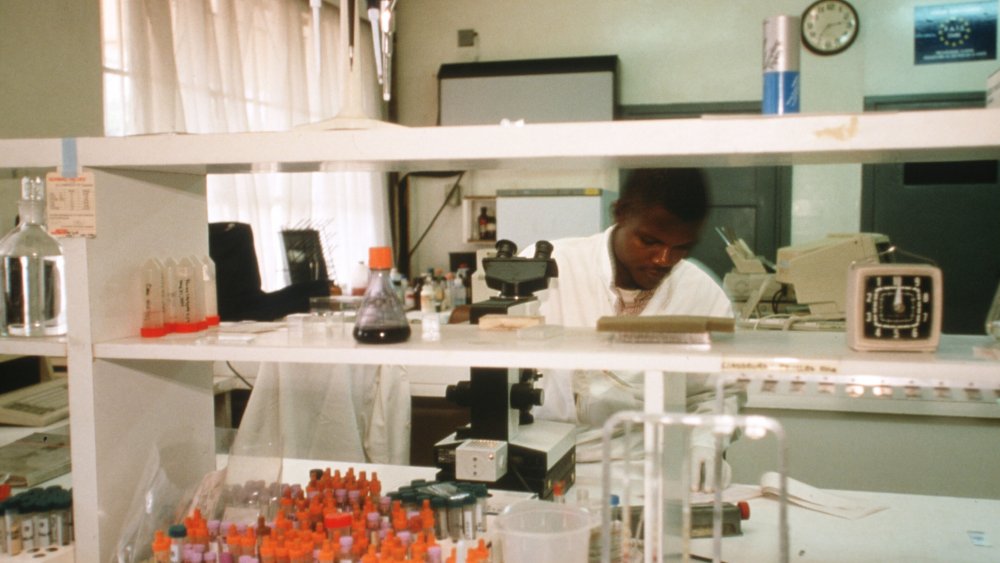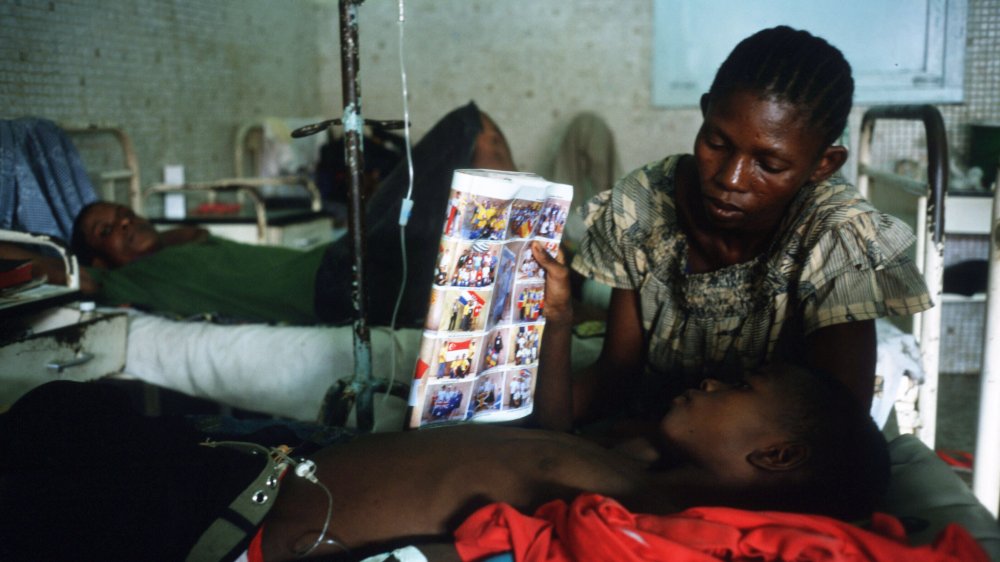The Messed Up History Of HIV/AIDS
Compared to the history of other diseases, HIV/AIDS is considered to be a fairly recent disease. While the first verifiable case of HIV comes from a 1959 blood sample, new research suggests that HIV began spreading among people as early as 1884.
HIV can be spread through blood, certain bodily fluids during sexual contact, and from mother to child via breastmilk. Infected needles or syringes can also be a source of transmission. Although there is no cure for HIV, it can be managed through antiretroviral treatments that reduce the virus to undetectable amounts. Condoms are also the most effective way to prevent HIV during sexual contact.
Historically, the HIV/AIDS epidemic was exacerbated by colonialism and was able to spread throughout the 20th century as a result of the stigma against HIV+ individuals and governmental indifference. Currently worldwide, over 36 million adults and 1.8 million children under the age of 15 are currently living with HIV. And since the virus was first distinguished in the 1980s, over 30 million people have died as a result of HIV/AIDS. And while countries in East and Southern Africa have reported declining HIV rates in recent years, Eastern European and Central Asian countries have reported upwards of a 30% increase in HIV infection rates between 2010 and 2018. This is the messed up history of HIV/AIDS.
HIV as a retrovirus
The human immunodeficiency viruses, also known as HIV, are a type of retrovirus that causes a condition known as acquired immunodeficiency syndrome, or AIDS. The difference between a retrovirus and a typical virus, or a provirus, has to do with how the virus replicates itself within the host.
A typical virus transcribes its DNA or RNA within its host and then translates the resulting RNA into protein. According to the UC Berkeley Museum of Paleontology, the virus uses the host cell to reproduce, and the infected cell creates viral proteins instead of its normal cellular proteins, eventually destroying the host cell.
A retrovirus, on the other hand, reverse-transcribes its own RNA into DNA first and then undergoes the process of replication within the cell. According to Healthline, this makes the viral DNA especially compatible with the host cell's genetic material, which allows the viral DNA to easily insert itself into the host cell's DNA, where the virus then commandeers the host cell in order to create more viral RNA and viral protein.
It's because HIV is a retrovirus that makes it so difficult to create a vaccine. Since HIV incorporates its own genetic material into the host DNA, it's able to essentially hide in the host cells from anti-viral therapy, mutating quickly, and maintaining the ability to recreate itself.
Strains and symptoms of HIV
There are two different types of HIV: HIV-1 and HIV-2. HIV-1 is further divided into four groups; groups M, N, O, and P. HIV-1 is the most common form, and group M causes about 90% of all HIV-1 cases. HIV-2 is primarily only found in West Africa and, according to The Origins of AIDS by Jacques Pepin, the types have undergone so many mutations that the gene sequences of HIV-1 and HIV-2 differ by more than 50%.
According to Avert, while HIV-2 progresses more slowly and is less infectious than HIV-1, without treatment both types of HIV will eventually progress to AIDS. It's also possible to be infected with more than one strain, which is known as "superinfection," though this is incredibly rare and occurs in less than 4% of infections.
In the first stage of HIV, people with HIV experience flu-like symptoms within two to four weeks of being infected with the virus, including fever, muscle aches, and swollen lymph nodes. Afterward, the virus enters into a latent stage and though it's still present in the body, many people don't suffer from any symptoms although they're still infectious.
Without treatment, HIV eventually weakens the immune system to the point where it's no longer able to fight infections, a condition known as AIDS. At this stage, symptoms include pneumonia, rapid weight loss, and neurologic disorders. However, symptoms vary depending on which opportunistic infections have occurred as a result of the weakened immune system.
Theories of HIV's origin
Ever since HIV was identified in the 1980s, there has been a great deal of scientific debate and research into where the virus originated. By retroactively testing blood samples, scientists have been able to come up with a "family-tree" of HIV transmission.
HIV is believed to have crossed over to humans from an animal reservoir and while scientists believe that HIV evolved out of the simian immunodeficiency virus, or SIV, that occurs in chimpanzees, that might not be its entire origin story. According to National Geographic, the SIV in chimps that evolved into HIV might have arisen as a hybrid of the SIVs that infect red-capped mangabeys and greater spot-nosed monkeys. Since HIV is primarily transmitted through blood, chimps likely got the monkey viruses by eating infected monkeys and the hybrid virus was then later transmitted when humans came into contact with infected chimpanzee blood, becoming HIV-1.
One of the earliest verifiable cases of HIV occurred in 1959 in Kinshasa in what is now the Democratic Republic of Congo, though scientists believe the virus crossed over into humans by the turn of the twentieth century.
HIV in the early 20th century
The colonial invasion of Africa created a perfect storm of conditions that led to the spread of HIV/AIDS. Although the spread is often attributed to "an imagined 'cut hunter'" who began hunting chimpanzees during colonial rule, becoming patient zero after eating an infected chimpanzee, chimpanzee hunting wasn't new. However, colonial rule increased the frequency of contact between humans and chimpanzees, especially once colonial powers began demanding domesticated chimpanzees for entertainment.
The colonial demand for rubber led to an increased network of transit. Extensive railways were built by colonial powers to transport people and goods back and forth from the dense equatorial rain forests into major cities. And according to Al Jazeera, one million people were traveling through Kinshasa by train every year by the end of the 1940s. This allowed the virus to move from isolated pockets into larger cities.
Another outcome of colonial rule was the imposition of invasive medical practices, which led to the spread of diseases as a result of unhygienic practices. Between 1921 and 1956, French, Belgium, and British colonial powers implemented mandatory medical campaigns aimed at combating sleeping sickness, later targeting leprosy and syphilis as well. Not only was the medicine often ineffective and full of negative side effects, but also, tools weren't sterilized, leading to the further spread of infection. The spread of Hepatitis C is well-documented, so it's likely that HIV spread as well.
The amplification of HIV
By the mid-1900s, a blood transfusion program exploded in almost a third of African colonies and countries. According to the American Public Health Association, by 1970 one million blood transfusions were occurring per year in sub-Saharan Africa, and by the 1980s that number had risen to almost 2 million per year.
Since HIV is most effectively transmitted through infected blood and the ability to screen for HIV in blood wasn't invented until 1985, the increased frequency of blood transfusions likely played a large role in spreading HIV.
The practice of transfusing blood was a Western invention that dramatically increased as a result of World War II, and by 1953, the United States was collecting almost 4 million blood donations every year. Eager to show off the technological prowess of Western medicine, colonial powers introduced blood transfusions into several sub-Saharan African colonies before World War II and expanded the practice after the war.
According to the ALBION Centre, the second earliest case of HIV also comes from Kinshasa in 1960 and estimates claim that by the 1960s, upwards of 2,000 people in Africa were infected with HIV.
HIV is recognized in America
While HIV was likely present in Europe and North America well into the 20th century, it wouldn't be recognized until the 1980s. However, while there have been multiple attempts to identify the "patient zero" who initially brought the disease into the United States, according to The Guardian, HIV likely entered the country independently on several different occasions. This is demonstrated by the fact that the viruses in various cities were distinct from one another.
According to Ohio State University, the first public health report occurred in June 1981 after there was a series of atypical pneumonia cases in Los Angeles. After the CDC released their Morbidity and Mortality Weekly Report of June 5, doctors around the country realized that they'd seen similar cases in young men who were unable to fight off infections that otherwise weren't seen in healthy people.
Initially, HIV was called a "gay cancer" due to its outward manifestation in the gay community. But within a few years, doctors in Africa would realize that the disease they'd identified as "slim disease," which affected women as often as men, was likely due to the same virus affecting people in the United States.
The 4H Club
In 1982, the CDC in Atlanta, Georgia identified a group of people who'd recently immigrated to the United States from Haiti and were similarly suffering from a series of opportunistic infections. Within a year, the CDC released a list of groups that were at high-risk for HIV/AIDS, though the disease itself had not yet been named, including Haitian people in their list. According to Plus, the list also included hemophiliacs, heroin users, and homosexuals. As a result, the group was disparagingly dubbed the "4H Club" by the public.
This led to increased discrimination towards those deemed to be part of the "4H Club." People of Haitian descent were fired from their jobs or denied housing and employment. The stigma of being gay or trans also resulted in many being refused care in hospitals, even to this day. And since people thought that they could catch AIDS from a toilet seat or a sneeze, those with the disease were further marginalized.
According to "How We Closed the Guantánamo HIV Camp" by Michael Ratner, between 1991 and 1993, the United States ran a detention camp at Guantánamo Bay, Cuba, specifically for the purpose of detaining Haitian people who were HIV+. Since the United States had banned the admission of anyone who was HIV+ in 1987, Haitian refugees who were HIV+ were forced to either stay in the detention camp or return to potential persecution and death in Haiti.
AIDS is named and ignored
In 1982, the CDC coined the term AIDS in an attempt to apply a more neutral name than "Gay-Related Immune Deficiency." But despite being named, the conservative administrations under both Prime Minister Margaret Thatcher in the United Kingdom and President Ronald Reagan in the United States ignored and avoided the conversation until the mid-1980s.
While the World Health Organization held its first meeting about the global AIDS crisis by the end of 1983, President Reagan didn't even say "AIDS" publicly until 1985. According to Vanity Fair, by that point over 5,000 people had already died from HIV/AIDS.
The growing AIDS crisis was treated as a joke by the Reagan administration. The documentary When AIDS Was Funny by Scott Calonico reveals audio from three press conferences in 1982, '83, and '84, in which White House officials respond to questions about the growing AIDS crisis with apathy, laughter, and homophobic jokes.
When it was spoken of, AIDS victims were disparaged. Pat Buchanan, the president's communication director at the time, even claimed that AIDS was "nature's revenge on gay men." Around the world, waves of protests spread against the governmental apathy towards HIV/AIDS. In the United States, Act Up was founded by civilians as a political action group in 1987 to combat the HIV/AIDS crisis.
Project SIDA
While many in North America and Europe continued to associate HIV/AIDS with marginal groups, doctors in Africa such as Kapita Bila recorded similar rates of infection amongst men and women and realized that HIV was just as transmittable amongst heterosexuals as it was homosexuals. But this understanding wouldn't spread worldwide until Project SIDA.
In the United States, Dr. Jonathan Mann was one of the few who truly realized the deadly nature of HIV/AIDS. According to Zeit Online, Dr. Mann set up Project SIDA in Zaire, now the Democratic Republic of Congo, in 1984 in collaboration with doctors from both Zaire and Belgium as well as the CDC. Project SIDA not only studied the prevalence of HIV/AIDS but worked with scientists and doctors towards treatment and prevention.
According to Avert, HIV/AIDS is largely understood as a result of the work done by the SIDA project. And Dr. Mann worked extensively to ensure that everyone, regardless of their gender or sexuality, received equal treatment for HIV/AIDS.
AIDS becomes a leading cause of death
Despite the research being done on HIV/AIDS, the stigma against the illness and its victims allowed the disease to run rampant in many communities around the world. In 1987, on average 80 people a week were dying of HIV/AIDS. According to Healthline, by 1995, AIDS was the leading cause of death for people aged 25-44 in the United States.
The rates of HIV infections also skyrocketed in Africa in the 1990s. In 1989, 1.2% of adults in Swaziland, now known as Eswatini, tested positive for HIV. Within 10 years, the rate had risen to 20.6%. In several countries, HIV/AIDS accounted for more than one in four deaths. In some places, like Zimbabwe, HIV/AIDS caused more than half of all deaths in the late 1990s.
Global deaths from HIV/AIDS reached their peak between 2004 and 2005 when upwards of two to three million people a year lost their life due to HIV/AIDS. According to UNAIDS, to this day, AIDS remains the leading cause of death globally amongst women aged 15 to 49.
By this point, many states in the United States had also implemented laws that criminalized HIV exposure. As of 2020, 37 states still have such laws.
The stigma of HIV
Homophobia greatly impeded the response to the AIDS crisis. Many who were gay didn't seek treatment when they were ill in order to avoid stigma and discrimination, while those who did seek treatment received the bare minimum of care. According to The New York Times, some doctors refused to accept AIDS patients or offer advice.
Even once admitted into a hospital, people with AIDS would be treated inhumanely by hospital staff. According to FIU Magazine, even though most scientists and health care workers understood that HIV wasn't highly contagious, many sought to avoid infection by any means. Hospital staff would leave AIDS patients in soiled sheets or they would leave food trays out in the hallways — where they would pile up since AIDS left people incredibly weak — in order to avoid entering the room of an AIDS patient.
Even doctors who treated AIDS experienced stigma and discrimination. In 1983, the first AIDS discrimination lawsuit, People v. West 12 Tenants Corp, came to a head when tenants in a cooperative apartment in New York City attempted to evict a doctor who lived in the building because of his work with people with AIDS. The chairman of the building reportedly stated that the tenants were "frightened of the AIDS patients and felt the nature of the doctor's practice would lower their apartment values."
Conspiracy theories about HIV
Because HIV/AIDS had the appearance of showing up out of the blue and it was something that people didn't understand, several conspiracy theories about it arose. Some of the conspiracy theories include beliefs that the HIV virus originated from a scientist, space, the pharmaceutical industry, or a vaccine.
But according to Time magazine, one of the most persistent rumors is the notion that HIV was invented by the CIA in order to wipe out Black people and gay people. Some even claim that gay men were deliberately infected in 1978 during the hepatitis-B studies in Los Angeles, San Francisco, and New York.
According to the Chicago Tribune, the theory that the United States government was responsible for HIV/AIDS was even promoted by the Soviet KGB, who claimed that HIV had been created by the United States and had escaped from a germ-warfare laboratory.
A 2006 study reported that almost a quarter of Black people and a fifth of Latinx people in the United States believe that AIDS was created by the United States government as a genocidal conspiracy. Despite the fact that conspiracy theories limit the ability to address and treat HIV, unfortunately, there's an abundance of historical precedent to understand their origins.
HIV/AIDS today
Although HIV/AIDS is still not curable, doctors have attempted to manage it with a number of different drugs. Azidothymidine, also known as AZT, was the first treatment for HIV and was introduced in 1987. In 1997, antiretroviral therapy, also known as HAART, became the new standard of treatment and brought the death rate down by 47%. However, ultimately all that antiretroviral drugs do is suppress the virus rather than destroy it.
But with antiretroviral therapy, people with HIV can have a lifespan as long as people without HIV. And in 2007, the first person was seemingly cured of HIV. After receiving bone marrow and stem cell transplants, Timothy Ray Brown appeared to be cured of both his HIV and leukemia. Unfortunately, he died in 2020 when his leukemia returned.
According to KFF, almost 40 million people are currently living with HIV worldwide. Since the global epidemic was declared in the 1980s, tens of millions of people have died. Two-thirds of people living with HIV in the world are located in sub-Saharan Africa.
And Juxtaposition Magazine posits that, despite claiming to help the AIDS crisis, pharmaceutical companies and their distribution of antiretroviral medication have exacerbated the HIV/AIDS epidemic through neo-colonialist practices. The 2014 research claims that by controlling access to treatment, pharmaceutical companies have sought to ensure that sub-Saharan Africa is dependent upon their antiretrovirals.













